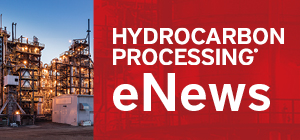
July 2022
Special Focus: Valves, Pumps, and Turbomachinery
Pressure relief valves (PRVs) protect process equipment from the hazards of excessive over-pressure.
Some of the highly corrosive fluids in the oil and gas industry contain the following compounds: carbon dioxide, hydrogen sulfide, chlorides and moisture.
Hydrogen recycle gas compressors are one of the most significant rotating equipment in oil refineries, petrochemical plants and upgraders.
Calculating flowrate through long, straight pipe in a zone of complete turbulence is easy using standard fluid mechanics equations.
Circular Economy
As resources become scarcer, and as costs continue to rise, companies are looking for new methods to reduce their material feedstock costs and remain competitive.
100th Anniversary
Several major impactful events took place in the global oil and gas and petrochemical industries in the 1980s.
Can a computer reduce your maintenance?
Process Optimization
The European climate has one of the harshest winter weather conditions—therefore, diesel products’ cold flow properties [i.e., cloud point (CP) and cold filter plugging point (CFPP) parameters] are key to ensure diesel products’ usability during these climate conditions.
Many large industrial facilities—including refineries, and chemical and petrochemical plants—are increasingly turning to co-generation for process steam and power production.
A caustic tower is a critical piece of equipment in an ethylene plant that supplies feed to the downstream section after removing impurities.
Catalysts
Hydroprocessing (hydrotreating and hydrocracking) units are high-pressure, high-temperature units that have multiple reactors, multiple beds per reactor and specialized metallurgy.
Maintenance and Reliability
Aboveground storage tanks are used in several industries with different fluid services. These
When identifying solutions that can offer assurance and longevity, the maintenance and reliability of asset repairs can be challenging.
Columns
One of the most critical aspects of plant operations is controlling the flow of liquids and gases throughout refining and petrochemical process units.
Liquid-ring compressors (FIG. 1) use the centrifugal whirling of a sealing liquid to create a series of piston-like water columns to trap gas or vapor between the impeller cells of a rotor installed eccentric to its casing.
Operations in the oil and gas, petrochemical and refining industries pose a higher risk when failures occur in identifying ongoing damage mechanisms within static equipment.
Flaring is the controlled burning of hydrocarbons at oil refineries, gas processing plants and petrochemical plants.
Operators may use a variety of tools and techniques—hardware solutions, software packages and sensor technologies—to monitor and manage different aspects of plant performance.
Determining the required installation torque for a tight flange system is a daily challenge for industrial valve manufacturers and plant operators.
Trends & Resources
In 1H 2022, new capital projects have declined 19% vs. 1H 2021.
What is the harm in wearing a knock-off Rolex watch?
The Thermo Scientific Delta Q isotope ratio mass spectrometer (IRMS) is a next-generation gas IRMS designed to enable detailed analysis with greater precision and accuracy.

- Petrobras wrapping up due diligence to buy back refinery from Mubadala 7/26
- US court rejects EPA denials of 2022 small refinery biofuel waivers 7/26
- Mexico seeks more 2025 fuel import deals after refinery delays 7/26
- PETRONAS, Eni and Euglena reach FID to construct a biorefinery in Malaysia 7/26
- ExxonMobil signs carbon capture agreement with CF Industries in Mississippi (U.S,) 7/26
- WoodMac: LNG truck sales impacting Chinese road diesel demand 7/26
- Digital Exclusive: SPECIAL FOCUS: Digital Technologies—Utilize process simulation digital twin to optimize condensate yield
- Digital Exclusive-Flare system design: Liquid pockets in flare headers
- Hydrogen-rich content gasoline: A new concept for paraffinic gasoline reformulation
- Alarm rationalization at Kuwait National Petroleum Company (KNPC) refineries




